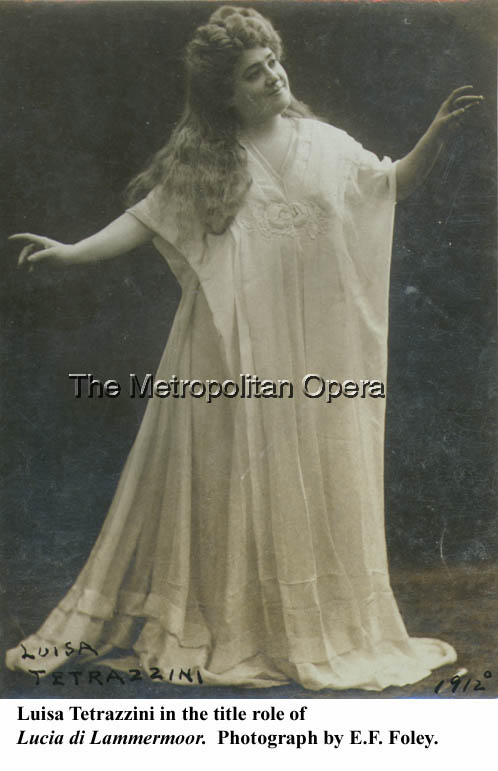Key Word Search
Multi-Field Search
Browse
Repertory Report
Performers Report
Contacts
Met Opera Website
Lucia di Lammermoor
Imperial Russian Ballet
Metropolitan Opera House, Wed, December 27, 1911
Debut : Luisa Tetrazzini
Lucia di Lammermoor (77)
Gaetano Donizetti | Salvadore Cammarano
- Lucia
- Luisa Tetrazzini [Debut]
- Edgardo
- Florencio Constantino
- Enrico
- Pasquale Amato
- Raimondo
- Herbert Witherspoon
- Normanno
- Pietro Audisio
- Alisa
- Marie Mattfeld
- Arturo
- Angelo Badà
- Conductor
- Giuseppe Sturani
- Director
- Jules Speck
Imperial Russian Ballet
Glinka: A Life for the Czar: Mazurka
Bronislawa Pajitzskaia, Alina Schmolz, Stanislava Kun, Stephania Plaskowietzkaia, Geanina Mezkowskaia, Franciscek Markowski, Alexis Trojanowski, Veronine West, Franciscek Mezkowski, Kyprian Barboe, Mr. Marshat
Nocturne
Ekaterina Geltzer, Mikail Mordkin
Variation
Ekaterina Geltzer
Grieg: Anitra's Dance
Bronislawa Pajitzskaia
Saint-Saëns: Gypsy Dance
Mikail Mordkin
Variation
Ekaterina Geltzer
Chopin: Les Papillons
Alina Schmolz, Stephania Plaskowietzkaia
Czibulka: Variation
Alexandre Volinine
Etude
Ekaterina Geltzer, Mikail Mordkin
Liszt: Hungarian Rhapsody No. 2
Bronislawa Pajitzskaia, Alina Schmolz, Stanislava Kun, Stephania Plaskowietzkaia, Geanina Mezkowskaia, Alexis Trojanowski, Kyprian Barboe, Veronine West, Franciscek Markowski, Mr. Mashat
Conductor...............Vittorio Podesti
The sextet was repeated
Review 1:
Review of W. J. Henderson in the New York Sun:
Mme. Tetrazzini was accompanied by, associated with and otherwise aided and abetted by Florencio Constantino, tenor. These two belong to the interstate operatic league, which sings in Boston, Philadelphia, Chicago and New York. The others implicated in last night's doings were members of the local company. Let them be dismissed at the outset with such blessings as they deserve. Pasquale Amato was a competent Enrico Ashton, and made all the trouble in the lyric drama with the skill of a barytone long practiced in such arts. Herbert Witherspoon was the Raimondo.
Mme. Tetrazzini has long been popular in the rôle of Lucia. At Mr. Hammerstein's bought and paid for Manhattan she always attracted and interested large audiences in this part. Last night the house was sold out. But this fact did not stir Mme. Tetrazzini's artistic conscience to unwonted activity. She sang in the same manner as she did before she came out of West Thirty-fourth street. Her sins were perhaps greater in degree, but not different in kind. Her virtues were the same in all respects.
There is nothing new to be said about the quality-or rather qualities-of her tone. She does not expose so much the infantile timbre of her low register, but she had introduced this improvement before Mr. Hammerstein had ceased to be an impresario. Her upper tones are as full and brilliant as they used to be and the tremolo afflicts her in the same old places.
She has the same scintillating and amazing staccati and she introduces them entirely for their own sweet sake and with a queenly disregard for the rhythm of the melody or the outline of the phrases. To come to the summary of the whole matter, Mme. Tetrazzini is now, as she was when New York first made her acquaintance, a vocal virtuoso who has a small stock of extremely effective artifices. These she uses over and over again without any attempt to hide her purpose which is to focus attention on certain splendid tones of her voice and on her command of the artifices themselves. But one grows weary of reiterated holds which are made in order to introduce long swelling notes, and of other technical tricks when used simply for the passing effect.
One evil result of this practice is that when Mme. Tetrazzini places the devices properly in a number they fail to make any musical impression. They leap out of their background into undesirable prominence because the hearer merely scores mentally another repetition of a worn device. It is a pity too that the distinguished contralto [sic] has not a warmer affection for music as music. If she had she would not distort a phrase in order to prepare the breath for a prolonged swell in the next phrase.
Indeed there is so much to enjoy in the beauty of a certain part of Mme. Tetrazzini's unique voice that it is most regrettable that she detracts from her own possibilities by unmusical singing. She gains much applause from those who clearly love to be astonished by skill in the performance of difficult vocal feats but she grieves those to whom high musicianship stands above technical facility.In the famous sextet Mme. Tetrazzini put more genuine art to her credit than in any other part of the opera. She sang in this number with dignity of style, finely sustained breadth of phrase and consistent beauty of tone. She and her associates gave such an excellent delivery of the number that the audience compelled its repetition.
Photograph of Luisa Tetrazzini as Lucia di Lammermoor by E. F. Foley
Search by season: 1911-12
Search by title: Lucia di Lammermoor, Imperial Russian Ballet,
Met careers
- Giuseppe Sturani [Conductor]
- Luisa Tetrazzini [Lucia]
- Florencio Constantino [Edgardo]
- Pasquale Amato [Enrico]
- Herbert Witherspoon [Raimondo]
- Pietro Audisio [Normanno]
- Marie Mattfeld [Alisa]
- Angelo Badà [Arturo]
- Jules Speck [Director]
- Tetrazzini/Constantino/Amato/Witherspoon/Mattfeld/Badà [Lucia di Lammermoor: Sextet: Repeat]
- Vittorio Podesti [Mazurka: Conductor]
- Kyprian Barboe [Mazurka]
- Stanislava Kun [Mazurka]
- Franciscek Markowski [Mazurka]
- Geanina Mezkowskaia [Mazurka]
- Franciscek Mezkowski [Mazurka]
- Bronislawa Pajitzskaia [Mazurka]
- Stephania Plaskowietzkaia [Mazurka]
- Alina Schmolz [Mazurka]
- Alexis Trojanowski [Mazurka]
- Veronine West [Mazurka]
- Mr. Mashat [Mazurka]
